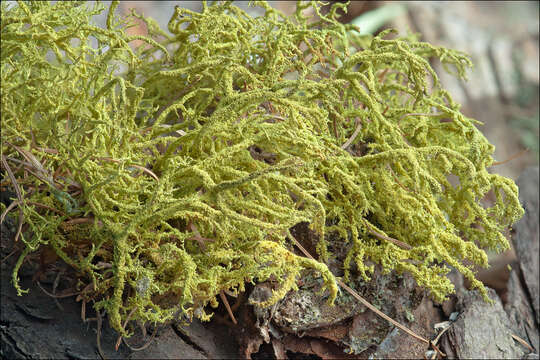Letharia-vulpina_1

Description :
Letharia vulpina (L.) Hue., syn.: Evernia vulpina Ach.Family: ParmeliaceaeWolf lichen, DE: WolfsflechteSlo.: volji liajDat.: Aug. 18. 2017Lat.: 46.46818 Long.: 13.51873Code: Bot_1080/2017_DSC8603 Habitat: old coniferous mountain forest, predominantly Larix decidua with some Picea abies; steep mountain slope, northeast aspect; calcareous ground, mostly in shade; partly protected from direct rain by tree canopy; average precipitations ~ 2.800 mm/year, average temperature 1-3 deg C, elevations 1.760 m (5.650 feet), alpine phytogeographical region. Substratum: on bark of old, living Larix decidua tree.Place: Mont Kamniti Lovec, 2.071 m (6.795 feet) mountain group; northwest of the pick; above the dirt road from village Ovja vas (Valbruna) to Svete Viarje (Borgo Lussari), near mountain trail 617, West Julian Alps, Friuli Venezia Giulia, Italy EC. Comment: Letharia vulpina is a species distributed mainly in West USA. However, it can be found also in Europe, mostly in mountains of Norway and less frequently in the Alps including southeast Alps in Slovenia. A few times it has been found also in mountains of Turkey.This species is quite rare and hard to find in my country in spite of the fact that it is conspicuous because of its bright color. It is very easy to recognize it. Its bright yellow or greenish-yellow, heavily sorediate thallus and typical habitus cannot be misidentified. Nevertheless, it is quite variable and its final taxonomy is yet to be agreed upon. Over ten var. and f. subtaxa have been described, but their relevance is still discussed. Apothecia are almost never encountered. This lichen is poisonous and was once used to poison foxes and wolfs. It contains yellow vulpinic acid, which dissolves in water if you soak the thallus in it and makes it yellow. It is speculated that its biological function is as a repellent for some herbivores. All chemical reactions are negative but one actually doesn't need them for reliable identification since its morphological traits suffice.Ref.:(1) Personal communication with Dr. Igor Dakskobler, Scientific Research Center of the Slovenian Academy of Sciences.(2) lichenportal.org/portal/taxa/index.php?taxon=54471 (access 19.8.2017)(3) I.M. Brodo, S.D. Sharnoff, S. Sharnoff, Lichens of North America, Yale Uni. Press (2001), p 412.(4) V. Wirth, R. Duell, Farbatlas Flechten und Moose, Ulmer, (2000), p 34.(5) V. Wirth, Die Flechten Baden-Wrttembergs, Teil. 2., Ulmer (1995), p 556.(6) B. Marbach, C. Kainz, Moose, Farne und Flechten, BLV Naturfrer (2002), p 78.
Inclus dans les pages suivantes :
- Life
- Cellular (Organismes cellulaires)
- Eukaryota (eucaryotes)
- Opisthokonta
- Nucletmycea
- Fungi
- Dikarya
- Ascomycota
- Lecanoromycetes
- Lecanorales
- Parmeliaceae
- Letharia
- Letharia vulpina
Cette image ne figure dans aucune collection.
Informations sur la provenance
- licence
- cc-by-nc-sa
- droit d’auteur
- Amadej Trnkoczy
- photographe
- Amadej Trnkoczy
- original
- fichier de média d’origine
- visiter la source
- site partenaire
- Flickr Group
- ID


